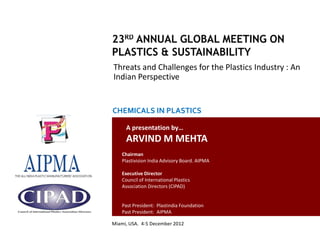
3 chemicals in plastics
- 1. Threats and Challenges for the Plastics Industry : An Indian Perspective CHEMICALS IN PLASTICS A presentation by… ARVIND M MEHTA Chairman Plastivision India Advisory Board. AIPMA Executive Director Council of International Plastics Association Directors (CIPAD) Past President: Plastindia Foundation Past President: AIPMA Miami, USA. 4-5 December 2012 Country Report: Plastics Industry in India- Issues and Challenges
- 2. Awareness is picking up slowly in India We want to learn from other countries as chemicals in plastics are threats Chemicals in Plastics 2
- 3. Majority of toys in Indian market contain toxic chemical: Study • CSE study in 2010 showed that even toys marked as safe for infants and toddlers were found to contain dangerous levels of the chemicals • Over 45% of the samples exceeded internationally accepted safe limits for phthalates • BIS released draft regulations on phthalates in toys – DEHP, DBP, DIDP, DNOP - regulated to be less than 0.1% Pesticide residues in bottled water Between July and December 2002, CSE tested 17 different brands of PDW and PNMW commonly sold in areas that fall within Delhi NCR & found the samples for 12 organochlorines, and 8 organophosphorus pesticides - covering the spectrum of pesticides most used in India BFR in recycled plastic across Delhi • Delhi-based NGO Toxics Link, in its study (2011), found the presence of brominated flame retardants (BFR) in recycled plastic across Delhi • Of the 44 samples that were collected from recycling and moulding units for the study, 18 were found to contain BFR and heavy metals like lead and cadmium Source: CSE-Centre for Science and Environment, The Economic Times Chemicals in Plastics 3
- 4. • Packaged Drinking Water and Packaged Natural Mineral Water are under mandatory BIS certification as per the PFA Rules, 1955 administered by Ministry of Health & Family Welfare, Govt. of India. • Packaged drinking water and natural mineral water shall be packed in clean, hygenic, colorless, transparent and tamperproof bottles/containers: o made of PE conforming to IS 10146 o or PVC conforming to IS 10151 or o PP conforming to IS 10910 o or PET and PBT conforming to IS 12252 o or polycarbonate conforming to IS 14971 o or PS conforming to IS 10142 o or sterile glass bottles suitable for preventing possible adulteration or o contamination of the water or PE bags conforming to IS 15609 • Plastic containers shall be conforming to IS 15410 • All packaging materials of plastic origin shall pass the overall migration and colour • migration limits as laid down in the relevant Indian Standards as per method given in • IS9845 Source: BIS-Bureau of Indian Standards, ICPE Chemicals in Plastics 4
- 5. • Bisphenol A (BPA) and phthalates o Found In: Water bottles, baby bottles, plastic wraps, food packaging Endocrine disruptor developmental problems • Propylene Glycol & Polyethylene Glycol o Used in industrial cleaners, anti-freeze, oven-cleaner, and hydraulic fluid ▪ Allegedly are carcinogenic and have been shown to be related to kidney problems, dermatitis, liver problems and weakened immunity • Sodium Lauryl Sulfate & Sodium Laureth Sulfate o Found in foaming agents like in certain soaps, shampoos, toothpastes, and many industrial cleaners like car wash soap. ▪ Denature proteins damage cells, Eye malformation in children and depression • Perfluorooctanoic Acid (PFOA) o A component of Teflon nonstick coatings ; found In nonstick pots and pans ▪ Hormone disruptor Limited awareness in India; some research being carried out by Govt. agencies – unlikely to impact plastics use in the immediate future Chemicals in Plastics 5
- 6. • IS: 9833-1981: List of pigments and colourants for use of plastics in contact with foodstuffs/pharma/drinking water • IS: 10141-1982: Positive list of constituents of PE for its safe use in contact with foodstuffs/pharma/drinking water • IS: 10142-1982: Specification for styrene polymers for its safe use in contact with foodstuffs/pharma/drinking water • IS: 10146-1982: Polyethylene for its safe use in contact with foodstuffs and drinking water • IS: 10148-1982: Positive list of constituents of PVC &its copolymers for safe contact with foodstuffs/pharma/water • IS: 10149-1982: Positive list of constituents of styrene polymers in contact with foodstuffs/pharma/drinking water • IS: 10151-1982: PVC and its co-polymers for its safe use in contact with foodstuffs/pharma/drinking water • IS: 10910-1984: Positive list of constituents of PP& its copolymers for its safe use in contact with foodstuffs/pharma • IS: 11434-1985: Ionomer resins for its safe use in contact with foodstuff, pharmaceuticals and drinking water • IS: 11435-1985: Positive list of constituents of ionomer resins in contact with foodstuffs, pharmaceuticals & water • IS: 11704-1986: Ethylene acrylic acid (EAA) copolymers for their safe use in contact with foodstuffs/pharma/water Chemicals in Plastics Source: BIS-Bureau of Indian Standards, ICPE 6
- 7. • IS: 11705-1986: Positive list of EAA copolymers in contact with foodstuffs, pharmaceuticals and drinking water • IS: 12229-1987: Positive list of constituents of PET & PBT for their safe use in contact with foodstuffs/pharma/water • IS: 12247-1988: Nylon-6 polymer for its safe use in contact with foodstuffs, pharmaceuticals and drinking water • IS: 12248-1988: Positive list of constituents of Nylon-6 polymer for its safe use in contact with foodstuffs/pharma • IS: 12252-1987: PET & PBT for their safe use in contact with foodstuffs, pharmaceuticals and drinking water • IS: 9845-1998: Method of analysis for the determination of specific and/or overall migration of constituents of plastics materials and articles intended to come into contact with food stuffs • IS: 13449-1992: Positive list of constituents of EVA copolymers in contact with foodstuffs/pharma/drinking water • IS: 13576-1992: EMA for its safe use in contact with foodstuffs, pharmaceuticals and drinking water • IS: 13601-1993: EVA co-polymers for its safe use in contact with foodstuffs, pharmaceuticals and drinking water • IS: 14972-2001: Positive list of constituents of polycarbonate in contact with foodstuffs/pharma/drinking water Chemicals in Plastics Source: BIS-Bureau of Indian Standards, ICPE 7
- 8. Thank you Chemicals in Plastics 8